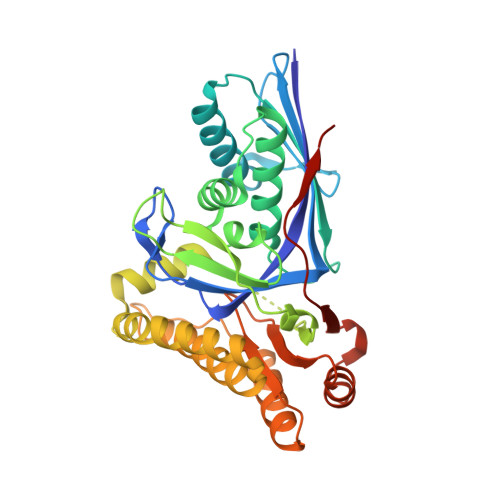Mevalonate 5-diphosphate mediates ATP binding to the mevalonate diphosphate decarboxylase from the bacterial pathogen Enterococcus faecalis.
Chen, C.L., Mermoud, J.C., Paul, L.N., Steussy, C.N., Stauffacher, C.V.(2017) J Biol Chem 292: 21340-21351
- PubMed: 29025876
- DOI: https://doi.org/10.1074/jbc.M117.802223
- Primary Citation of Related Structures:
5V2L, 5V2M - PubMed Abstract:
The mevalonate pathway produces isopentenyl diphosphate (IPP), a building block for polyisoprenoid synthesis, and is a crucial pathway for growth of the human bacterial pathogen Enterococcus faecalis The final enzyme in this pathway, mevalonate diphosphate decarboxylase (MDD), acts on mevalonate diphosphate (MVAPP) to produce IPP while consuming ATP. This essential enzyme has been suggested as a therapeutic target for the treatment of drug-resistant bacterial infections. Here, we report functional and structural studies on the mevalonate diphosphate decarboxylase from E. faecalis (MDD EF ). The MDD EF crystal structure in complex with ATP (MDD EF -ATP) revealed that the phosphate-binding loop (amino acids 97-105) is not involved in ATP binding and that the phosphate tail of ATP in this structure is in an outward-facing position pointing away from the active site. This suggested that binding of MDD EF to MVAPP is necessary to guide ATP into a catalytically favorable position. Enzymology experiments show that the MDD EF performs a sequential ordered bi-substrate reaction with MVAPP as the first substrate, consistent with the isothermal titration calorimetry (ITC) experiments. On the basis of ITC results, we propose that this initial prerequisite binding of MVAPP enhances ATP binding. In summary, our findings reveal a substrate-induced substrate-binding event that occurs during the MDD EF -catalyzed reaction. The disengagement of the phosphate-binding loop concomitant with the alternative ATP-binding configuration may provide the structural basis for antimicrobial design against these pathogenic enterococci.
Organizational Affiliation:
From the Department of Biological Sciences and.
















